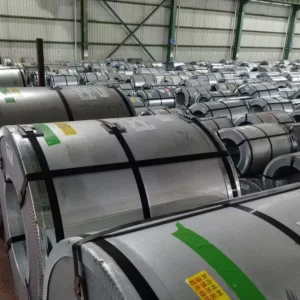Introduction
In the rapidly evolving world of energy efficiency and electrification, cold rolled electrical steel has become an indispensable material. From power transformers and electric motors to modern transportation and renewable energy systems, this engineered steel is at the heart of electromagnetic performance.
This blog provides a comprehensive look into cold rolled electrical steel—its manufacturing process, physical properties, application areas, and its critical role in meeting the efficiency demands of industries across Europe and the Middle East.
What is Cold Rolled Electrical Steel?
Cold rolled electrical steel, also known as silicon steel or lamination steel, is a type of specialty steel manufactured with a precise level of silicon content and carefully controlled microstructure. It is designed to have excellent magnetic properties, minimal core loss, and high permeability, making it ideal for components that operate in magnetic circuits.
The term “cold rolled” refers to the steel’s manufacturing process, where it is passed through rollers at room temperature to achieve its final thickness and desired mechanical and magnetic characteristics.
There are two main categories:
- Grain-Oriented Electrical Steel (GOES): Used primarily in power and distribution transformers.
- Non-Grain-Oriented Electrical Steel (NGOES): Used in rotating machines like electric motors, generators, compressors, and household appliances.
Manufacturing Process of Cold Rolled Electrical Steel
The production process for cold rolled electrical steel is both technically complex and highly refined, ensuring optimal performance in electromagnetic systems.
- Hot Rolling and Pickling: The process begins with hot rolling slabs to produce steel coils, which are then pickled to remove oxides.
- Cold Rolling: The steel is reduced to the required thickness through cold rolling, significantly improving surface finish and dimensional control.
- Annealing: Heat treatment restores ductility and enhances magnetic properties through grain refinement.
- Coating: An insulation layer is applied to reduce eddy currents and prevent corrosion, often using phosphate or organic coatings.
- Slitting and Cutting: The final step involves slitting coils or cutting sheets to precise dimensions suitable for various end uses.
Each step is monitored to ensure the finished product meets tight specifications for magnetic loss, resistivity, surface quality, and flatness.
Key Properties and Benefits
Cold rolled electrical steel exhibits several critical features that contribute to energy savings and high efficiency:
- Low Core Loss: Core loss reduction is vital for transformer and motor efficiency. Cold rolled steel minimizes hysteresis and eddy current losses.
- High Permeability: This enhances magnetic flux performance, allowing devices to operate at lower energy consumption levels.
- Excellent Surface Insulation: Coatings reduce inter-laminar loss and ensure effective magnetic isolation.
- Dimensional Precision: Consistent thickness and flatness allow for tight stacking and minimal air gaps in cores.
- Mechanical Strength: The steel maintains structural integrity under high-speed rotation or thermal cycling.
These benefits contribute to a longer lifespan and more reliable performance in energy-related systems.
Applications Across Sectors
1. Power Infrastructure
Grain-oriented cold rolled electrical steel is crucial for transformer cores, ensuring low energy loss and reliable grid transmission. It supports smart grids and renewable integration in Europe and the Middle East, where electricity demand and efficiency standards continue to grow.
2. Electric Motors
Non-grain-oriented grades are widely used in industrial motors, electric vehicle drivetrains, fans, compressors, and domestic appliances. Their isotropic magnetic behavior ensures smooth operation and reduced heat generation.
3. Automotive Industry
The electric vehicle (EV) revolution is driving innovation in motor design. Cold rolled electrical steel is essential for high-speed, low-loss motor cores used in hybrid and battery-electric vehicles.
4. Renewable Energy
Wind turbine generators and solar inverters use cold rolled steel to ensure high energy conversion efficiency. Its reliability under fluctuating loads and temperatures makes it ideal for these demanding environments.
5. Rail and Aviation
Energy-efficient traction motors in rail systems and aerospace auxiliary power units depend on high-performance cold rolled electrical steel for reduced fuel usage and improved power density.
Growth in Europe and the Middle East
Europe:
Cold rolled electrical steel is a strategic material in meeting EU energy directives, including the Ecodesign and Energy Labelling Regulations. Countries such as Germany, France, and Italy are investing in energy-efficient buildings, smart grids, and electrified transport—all of which depend on high-quality electrical steel.
Middle East:
Infrastructure modernization across the Gulf region—especially in Saudi Arabia, the UAE, and Qatar—has created new opportunities. National Vision programs and investments in renewables require efficient motors and transformers, for which cold rolled electrical steel is the preferred material.
The material’s recyclability and compatibility with low-carbon initiatives also align with sustainability goals in both markets.
Recent Technological Advances
The future of cold rolled electrical steel is being shaped by technological progress:
- Ultra-Thin Grades: As motor speeds and frequencies increase, thinner laminations (0.18 mm or less) are being developed to reduce core losses further.
- Laser Domain Refinement: Applied to grain-oriented grades, this process decreases magnetic loss by optimizing domain structures.
- High-Frequency NGOES: These materials are being tailored for next-generation electric drive systems and high-speed motors in robotics and aerospace.
- Advanced Coatings: Environmentally friendly coatings offer enhanced electrical resistance while meeting international safety and emission standards.
These innovations are critical for meeting the evolving needs of modern electrical systems while maintaining compliance with strict global standards.
Why Cold Rolled Electrical Steel Matters Now
As the global community moves toward decarbonization and electrification, the importance of energy-efficient components cannot be overstated. Cold rolled electrical steel not only enhances performance but also supports sustainability initiatives by lowering overall power consumption and emissions.
With supply chains becoming more regionalized and quality demands increasing, sourcing reliable cold rolled electrical steel from certified manufacturers is a strategic priority for industries.
Conclusion
Cold rolled electrical steel is a vital enabler of modern energy systems. Its role in improving efficiency, reliability, and sustainability makes it a core material for transformers, motors, and power electronics across Europe and the Middle East.
By understanding its properties, applications, and global significance, engineers, manufacturers, and policy-makers can make informed decisions that align with the future of energy and infrastructure.
Whether you’re developing an electric vehicle, modernizing power grids, or building high-efficiency appliances, cold rolled electrical steel is the foundation of your success.
Let me know if you would like a PDF version, social media snippet, or Arabic/German translation for localized use.
询问 ChatGPT




